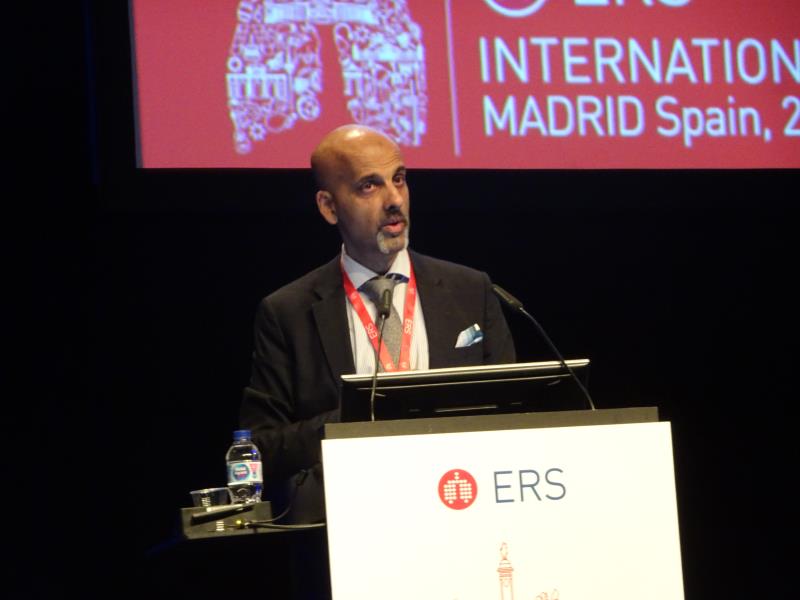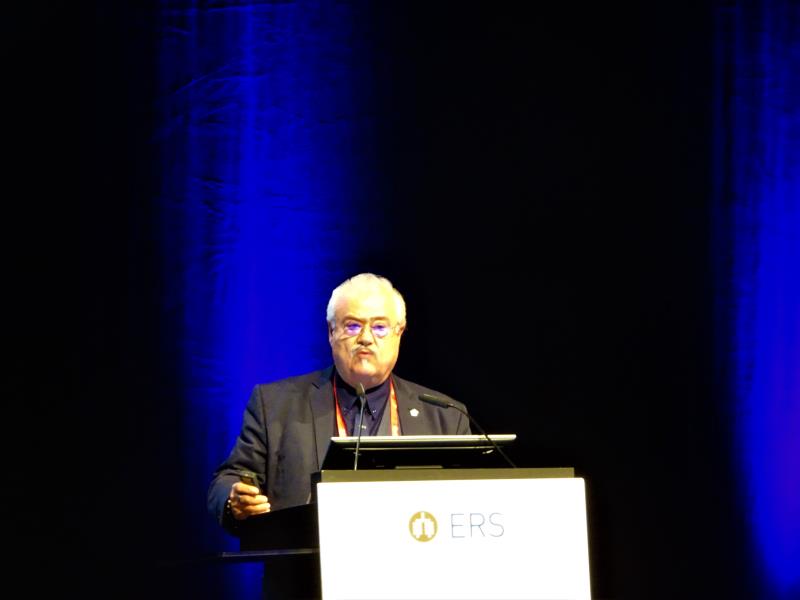 Dr Dave Singh
Dr Dave Singh“[Conventionally,] the addition of [LAMA] requires patients to use two different inhalers of different design with different instructions for use, and often with different dosing regimens. Such a combination is not only inconvenient for patients and healthcare providers who instruct on correct inhaler use, but can negatively affect treatment adherence and persistence,” the researchers pointed out.
Instead of using two inhalers, combining all three drugs in one inhaler “makes life easier for patients,” said Dr Dave Singh from the University of Manchester, UK, who presented the results at ERS 2019. “The use of single-inhaler triple therapy … ensured the delivery of all three components and should potentially optimize treatment adherence and persistence.”
A pooled analysis of both studies revealed that a triple therapy of ICS/LABA/LAMA in a single inhaler reduced the annual rate of severe asthma exacerbations by 23 percent (rate ratio [RR], 0.77; p=0.008) compared with a double therapy comprising ICS/LABA in patients with uncontrolled asthma, reported Singh. [Lancet 2019;doi:10.1016/S0140-6736(19)32215-9]
In addition, lung function assessed by predose FEV1## was also significantly improved with the triple therapy vs the double therapy in both studies (by 57 mL; p=0.008 in TRIMARAN and by 73 mL; p=0.0025 in TRIGGER).
The two multinational, double-blind, phase III trials enrolled a total of 2,592 patients (61 percent female) whose asthma was uncontrolled on ICS plus LABA, and who had ≥1 prior exacerbation in the previous year. In both studies, patients were randomized to a triple therapy of BDP/FF/G### or a double therapy of BDP/FF, two inhalations twice daily for 52 weeks, with an additional arm of open-label BDP/FF plus tiotropium in TRIGGER. While TRIMARAN recruited patients who were receiving medium-dose ICS, TRIGGER involved patients who were receiving high-dose ICS.
“[Although] the Global Initiative for Asthma report already includes recommendations for add-on LAMA use for patients whose asthma is not well controlled on ICS plus LABA therapy …these are the first studies to assess single-inhaler triple therapy in a broad asthma population not restricted to those with persistent airflow limitation,” Singh and colleagues highlighted.
Prespecified analysis: 6 factors predictive of response
When faced with patients with asthma uncontrolled on double therapy, information on which type of patients would most likely benefit from triple therapy can help clinicians in selecting patients for stepping up therapy, said Singh.
While predictors of response to add-on LAMA on FEV1 have been reported, predictors of response to the drug on severe asthma exacerbations remain unknown, he added.
To address this, Singh and colleagues performed a prespecified pooled analysis of patients in the two studies (1,146 patients on BDP/FF/GB and 1,145 on BDP/FF) who were stratified by different variables. Severe exacerbation was defined as worsening of asthma that requires the initiation of systemic corticosteroids for at least 3 days. “It is important to note that this was prespecified and not a post hoc analysis,” Singh said. [ERS 2019, abstract RCT3779]
“Six easily identifiable factors appear to be associated with the most prominent response to treatment, and may help in treatment step-up decision at the point of care,” he reported.
Younger age (<65 years; RR, 0.77; p=0.017), male (RR, 0.651; p=0.009), and lower BMI (<25 kg/m2; RR, 0.57; p=0.005) were associated with better responses to triple therapy in reducing severe asthma exacerbations.
In addition, patients who had one exacerbation (RR, 0.73; p=0.009 vs >1 exacerbations), a greater reversibility on FEV1 (>400 mL; RR, 0.73; p=0.024), and who never smoked (RR, 0.76; p=0.013) had better responses to triple therapy than those without such characteristics.
Nonetheless, the results should be considered hypothesis generating, according to Singh, who said these six predictors “give us something to build on for further analysis.”
Post hoc analysis: those with airflow limitation benefit more
While both studies included a broad asthma population, a post hoc analysis of the TRIGGER study showed that patients with persistent airflow limitation experienced a more pronounced reduction in moderate/severe exacerbations (by 25.9 percent vs 12.0 percent) and in severe exacerbations (by 31.8 percent vs 20.5 percent) when treated with high-dose BDP/FF/G compared with the overall population. [ERS 2019, abstract OA5339]
“Triple therapy with high ICS-dose extrafine BDP/FF/G may be particularly beneficial in reducing asthma exacerbations in patients who exhibit persistent airflow limitation,” said Dr Giorgio Canonica of Humanitas Research Hospital in Milan, Italy.
Triple therapy or biologics?
“This new treatment option is to be welcomed because it provides in one inhaler a simpler treatment option for patients with [uncontrolled] asthma,” wrote Drs J Mark FitzGerald and Mohsen Sadatsafavi from the University of British Columbia in Vancouver, Canada in a linked commentary. [Lancet 2019;doi:10.1016/S0140-6736(19)32216-0]
“An important consideration is whether, on a patient-by-patient case, clinicians should complete a trial of triple inhaler therapy before considering a more targeted treatment with a biologic,” they asked.
Given that there are excellent predictors of response and oral corticosteroid sparing effect with biologics, “an intermediate trial of [triple] therapy might not be appropriate for all patients,” suggested FitzGerald and Sadatsafavi.
“[At the same time,] we must continue to emphasize the importance of asthma education, inhaler technique, and adherence for all patients with asthma,” they advised.
 Dr Giorgio Canonica
Dr Giorgio Canonica